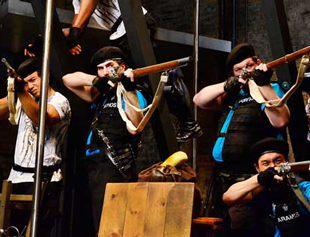
The playbill assures us that this is The Three Musketeers, but the trio of military lifers and the young civilian seeking to join their ranks are not the familiar Anglo-Norman cavaliers of Hollywood romps and candy-bar logos. Granting that even in the 17th century, it was possible to find Frenchmen with faces revealing African or Asian ancestors, and that multi-ethnic casting in storefront theaters is likewise far from unprecedented, the uniforms worn by these elite troops—kevlar vests, combat boots and berets of the kind we associate with desert commandos—clearly distinguish Robert Kauzlaric's adaptation of Alexander Dumas' sword-and-cloak romance from its predecessors.
"Dumas' novel was written in the midst of political turmoil, during an era of changing social and economical revolution," Kauzlaric explains, "The universe we were creating reflects a modern illustration of racial demographics—it was only logical that you'd have people of color in lead roles." This updated metaphor also highlights the significance of D'Artagnan, a native of the southern province of Gascony, finding himself a target of prejudice when he arrives in Paris. "Dumas modeled much of the fictional D'Artagnan on the experiences of his own father, who was of mixed-race background."
This particular adaptation's prototype premiered at the Illinois Shakespeare Festival in 2010, on a massive outdoor stage allowing widely-scattered scenes to be played simultaneously. The Lifeline Theatre performing space, by contrast, measures a mere 28 X 30 feet, its high ceiling mandating a scenic design like a giant jungle-jim, incorporating ladders, fireman-poles and multiple-levels eliminating the need for realistic entrances and exits. This, in turn, facilitates swift changes in locale.
"A reality of the Lifeline stage is that it lacks the real estate of the one at ISF." Kauzlaric admits, "Many of the split-screen scenes [in the earlier version] had to be re-thought, or cut altogether. Three actors are assigned the roles of all the constables, guardsmen, innkeepers and servants. In fact, since there are ten fewer actors in this production [than at ISF], pretty much everybody plays two or more characters."
What else will we see in this production that we don't in others? "Most adaptations focus on just one plot component—the diamonds, or Milady's secret past, or the siege of La Rochelle—but ours includes the whole story, including some elements usually considered too dark in tone for an action-adventure yarn. Oh, and something else that we found in lots of other adaptations, but that you won't find in ours, are additions to the plot, like introducing D'Artagnan's brothers and sisters."
Kauzlaric's script even differs from its own previous incarnation in the themes it explores "The 2010 play was period-specific, emphasizing the heroism and the virtue of our four protagonists. This time, we meditate on the nature of power and its corruption of innocent citizens struggling to survive in a cynical world."
In other words, if the many other page-to-stage Three Musketeers —including the hitherto-definitive Richard Lester films—could be compared to a comic book (albeit in the "Classics Illustrated" genre), the production currently occupying Lifeline Theatre is a graphic novel, its setting a flawed society in which good people die, villains go unpunished, and heroes roam mean streets, secure only in their own fraternity and its private code of honor.
The Three Musketeers runs at Lifeline Theatre through July 21.
Mary Shen Barnidge
Contributing Writer

 Follow Us On Twitter
Follow Us On Twitter